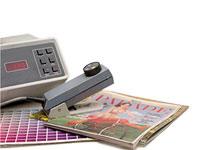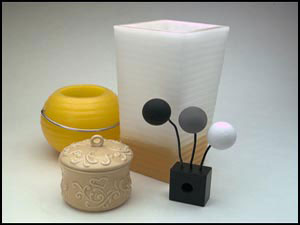The MegaVision Workflow MegaVision workflow - why is it worth considering over other digital capture solutions? 
MegaVision has been conceiving, designing and refining digital capture tools and software since the beginning of the genre. No company has more experience making and selling digital capture devices. Prior to Photoshop® and the modern computer, MegaVision developed an image processor, the 1024XM, and Capture Station software. Since Bayer pattern sensors had yet to be implemented commercially, MegaVision mechanized a rotating filter wheel to provide complete filtering of each channel and every pixel, synchronizing multiple strobe flashes via an infra-red wireless interface, for red, green, and blue filters. This understanding of technology resulted, in 1987, in the world's first commercially viable digital camera. 
Measured photography involved understanding the target from the printing press operator's point of view and it involved a measured validation that the picture file fit the target's measured characterization. Because newsprint, calendared web, coated web, and sheet fed presses have different amounts of measurable total ink density, MegaVision's digital capture file needed to match the specified press, which is why the modern Photoshoot capture application's contrast continues to be specified in D- log density. This was, and still is, a very accurate way to specify a picture's contrast because it's also perfectly suited to the modern photo targets-- inkjet, printing press, RA-4, and world wide web. All that's needed is a density measurement of the intended target for Photoshoot's density range setting. In the earliest days of digital capture -- before workflow, before Photoshop, before calibrated displays and color management -- some sort of viable methodology had to be conceived. The pictures had to be right or the fledgling digital capture concept would fail. The printing press community was required to accept the new workflow, as did the pre-press folks, because of the cost savings compared to a film based workflow. So MegaVision asked photographers what they wanted. And because photographers were far more comfortable with a photographic interface, Megavision did not force shooters to use a scanner interface. 
Most digital capture applications involve a scanner interface, including a curve box and a levels based densitometer. This system is best when scanning film where the contrast and color are already established in the emulsion and operators are looking for channel based information, it's not especially good for making images where professional lighting control is assumed and luminance based densitometer reporting can be used to validate the lighting. In the early days MegaVision chose a Polaroid- style digital proof image with a luminance based densitometer-- the same interface that is in use today. The early capture device had barely enough signal-to-noise performance to make a picture. The construction of a "digital emulsion" for the newsprint target was straightforward because there was no flexibility and no extra tonality to be used for higher ISO's or smoother transitions to highlight. Today, things are different-there is excess S/N relative to the reflective target, and the photographer can use the excess to fashion any kind of digital emulsion. All that is necessary to know is how to make the digital emulsion. Using Measured Photography, we can characterize the target and validate that the capture fits it perfectly. 
At the beginning of digital capture it was not simple to make a professional picture, so MegaVision designed hardware and software tools that professional photographers understood. Digital capture tools today are marketed to be easy, fast, and stylish - and accessible by anyone who purchases the latest and greatest capture device. But photography is still a craft and there are many choices to be made. Cameras are not good at making the critical choices, such as where the light should come from, how much fill to use, or where the highest and lowest important values should reside. Cameras don't make pictures, photographers do. MegaVision's Measured Photography concept depends on the photographer's input and provides tools that aid the crafting of a photographer's vision for a specific target. |
